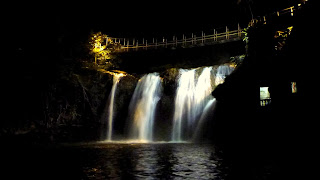An early pack up and refuel saw us on the road from Cooktown
shortly after nine. Our first priority was to return along the Mulligan Hwy. to
Lakeland to put the van in storage while we took off on our trip up the cape.
With securing the van taken care of it was time for morning tea before our
departure on the road to Laura. This road is now newly sealed and it seemed
like in no time we were at the ‘Split Rock’ aboriginal art site. With a short
climb up the escarpment we were marvelling at this unique and ancient, well
preserved Quinkan style art.
 |
| Split Rock Art Site |
Then on to Laura for a quick look around and a loo
break at the shady park. From here on we would not see too much sealed road and
although, in general the road conditions were quite good, the dust was very
apparent which meant keeping quite some distance between vehicles – thank
goodness for C.B. radios so we could keep in contact each other. Lunch was
taken at Hann River and then on to our first overnight camp at Morehead River
just south of Musgrave telegraph station. Here we put up our tent for the first
time in ages and even in the heat we had our camp completely set up in little
more than 30 minutes, leaving plenty of time to gather firewood before sunset,
Brian even managed some fishing in the river. He didn’t manage to catch
anything substantial but did manage to snag his lure in an overhanging tree,
which meant an interesting retrieval process was undertaken. After dinner we sat
round the campfire for while before retiring for a peaceful night’s sleep under
canvas.
 |
| Morehead River Camp |
I am afraid to keep describing our trip up the cape in
detail would take too long and be much too boring so let me summarise and then
let the pictures do the talking. In total it took us 12 days to go up and back.
Day two saw stops at Musgrave, Coen and Archer River before an overnight in
Weipa. Day three we travelled via Batavia Downs with stops at Moreton telegraph
station and Bramwell Junction before the start of the infamous ‘Old Telegraph
Track’ or the OTL as it is sometimes called. This track is totally
un-maintained and has become very rough and overgrown. We made it through the
first creek crossing without drama but unfortunately found the next, Palm
Creek, quite a different story. After much sizing up I decided to give it a try
but unfortunately was not able to climb out the other side and needed Brian’s
assistance to retreat doing a fair bit of damage to my vehicle in the process.
This took a lot of time and it was soon late afternoon so we decided to make
camp right beside the track. Never mind, with a campfire BBQ dinner and a few
drinks around the fire the dramas of the day were soon forgotten.
.JPG) |
| Palm Creek |
.JPG) |
| Al prepares dinner |
.JPG) |
| While Sue watches the fire |
Day four saw us retreat back to Bramwell Junction to travel
up the southern bypass road to reach one of the highlights of any trip up the
cape, Fruit Bat Falls and then on to Elliot Falls for our overnight camp.
 |
Bramwell Junction
 |
| Fruit Bat Falls |
 |
| Enjoying the waters below the falls |
|
 |
| Elliot Falls |
 |
| Twin Falls |
 |
| Sue & Petra get a massage at Twin Falls |














































.JPG)
.JPG)
.JPG)
.JPG)




















